
PUMPA - SMART LEARNING
எங்கள் ஆசிரியர்களுடன் 1-ஆன்-1 ஆலோசனை நேரத்தைப் பெறுங்கள். டாப்பர் ஆவதற்கு நாங்கள் பயிற்சி அளிப்போம்
Book Free DemoWater quality will degrade when water gets polluted with industrial waste, human waste, animal waste, garbage, untreated sewage, chemical effluents, etc. Drinking or cooking with such contaminated water leads to water-borne diseases caused by both bacteria and virus. Some of the diseases caused by the virus are Poliomyelitis, Hepatitis A and Acute Diarrhoea.
Disease: Poliomyelitis:
Causative organism: Polio virus
Poliovirus is highly contagious. This virus enters the brain and spinal cord through blood and affects the central nervous system.
Mode of transmission: Droplet infection, sputum discharge, secretion from nose, throat, contaminated water, food and milk.
Tissues/Organ affected: Central nervous system
Symptoms: Paralysis of limbs result in difficulty in walking.
Preventive and Control Measures: Salk’s vaccine or Oral Polio Vaccine (OPV) is administered.
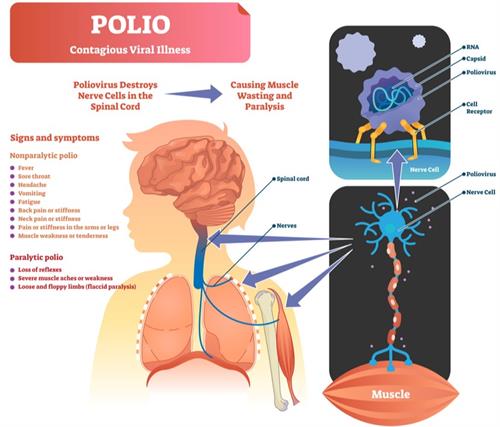
Polio
Pulse-Polio Immunisation programme:
Poliovirus is also called an enterovirus. It is primarily an infection of the alimentary tract. The most vulnerable age is between \(3\)-\(6\) years of age. Pulse Polio Programme was started in December \(1995\) in India. India has taken up a massive programme for the eradication of Polio under Pulse Polio Immunisation Programme in which young children are given polio vaccine drops orally.
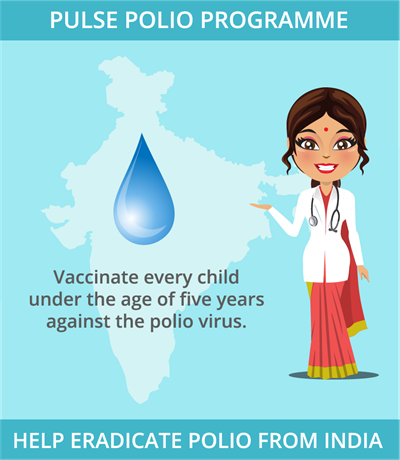
Pulse-Polio Programme
Achievements:
- No cases of polio have reported in India since \(13\)th January \(2011\).
- Without registering any polio cases for three years, World Health Organisation (WHO) declared India as ‘Polio-free country’ on \(13\)th January \(2014\).
Vaccine: Inactivated poliovirus vaccine (IPV) is an inactivated antigen used to kill the poliovirus.
Treatment: There is no specific treatment for poliomyelitis recovery from symptoms following infection. Symptoms may be slow and may take several weeks or months.
Note: Jonas Edward Salk, an American virologist, developed one of the first successful polio vaccines.
Disease: Hepatitis A
Mode of transmission: It is transmitted through contaminated water and food through the oral route.
Tissue/Organ affected: Inflammation of the Liver.
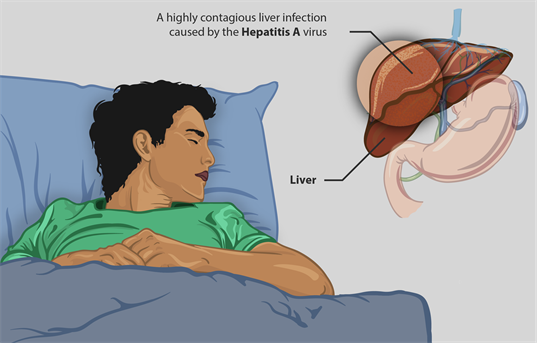
Picture depicting the suffering of a Hepatitis A infected person due to the infection in the liver
Symptoms:
- Nausea
- Anorexia (an eating disorder)
- Acute fever (yellow fever)
- Jaundice
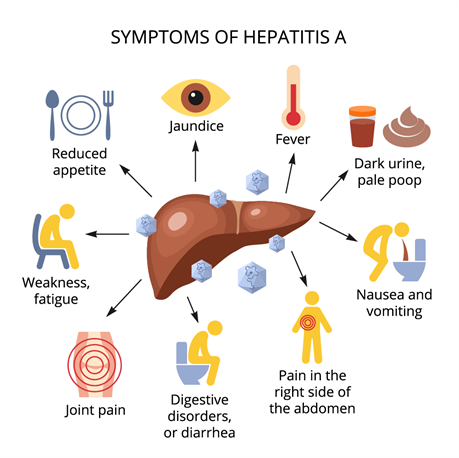
Symptoms of Hepatitis A
Note: Anorexia
Anorexia nervosa is an eating disorder with symptoms like
- Abnormal low body weight
- Intense fear of gaining weight
- Distorted perception of weight
Jaundice: Jaundice increases the bilirubin level (yellow-orange bile pigment), resulting in a condition that causes the skin, mucous membrane, and eyes white turn yellow.
Preventive and control measures: Prevention of food contamination, drinking chlorinated boiled water, personal hygiene will help prevent the spread of Hepatitis A.
Vaccine: Prevention of hepatitis A is through vaccination with the hepatitis A vaccine.
Treatment: There is no specific treatment for hepatitis A. Recovery from symptoms following infection may be slow and may take several weeks or months.
Disease: Acute diarrhoea:
Causative organism: Rotavirus
Mode of transmission: Contaminated water, food and oral route.
Tissue/Organ affected: Intestine.
Symptoms:
- Vomiting
- Fever
- Watery stools with mucus
- Sudden onset of three or more stools in a day
- Increased fluidity and volume of bowel movements resulting in an excessive electrolytes and fluid loss in the intestine.
Preventive and Control Measures: Proper sanitation and hygiene
Treatment: Rehydration
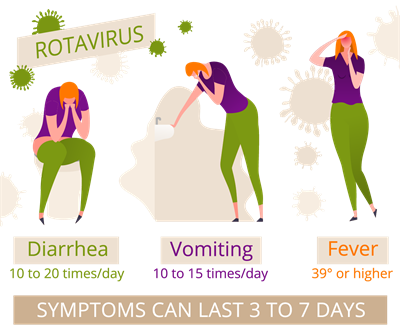
Symptoms of rotavirus
Reference:
https://upload.wikimedia.org/wikipedia/commons/6/6a/A_young_boy_suffering_from_Hepatitis-A.png